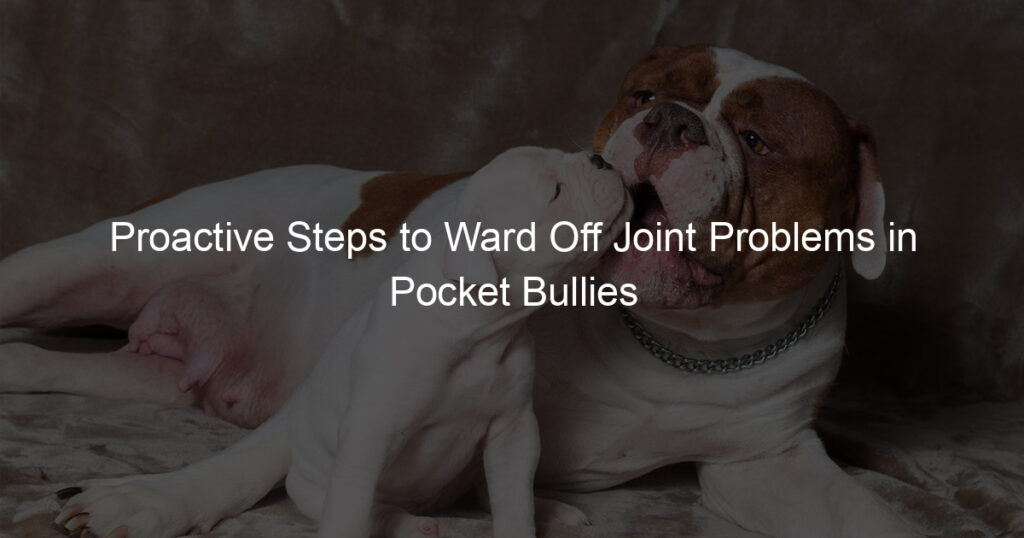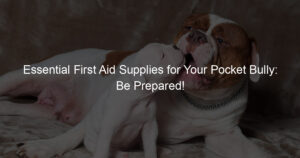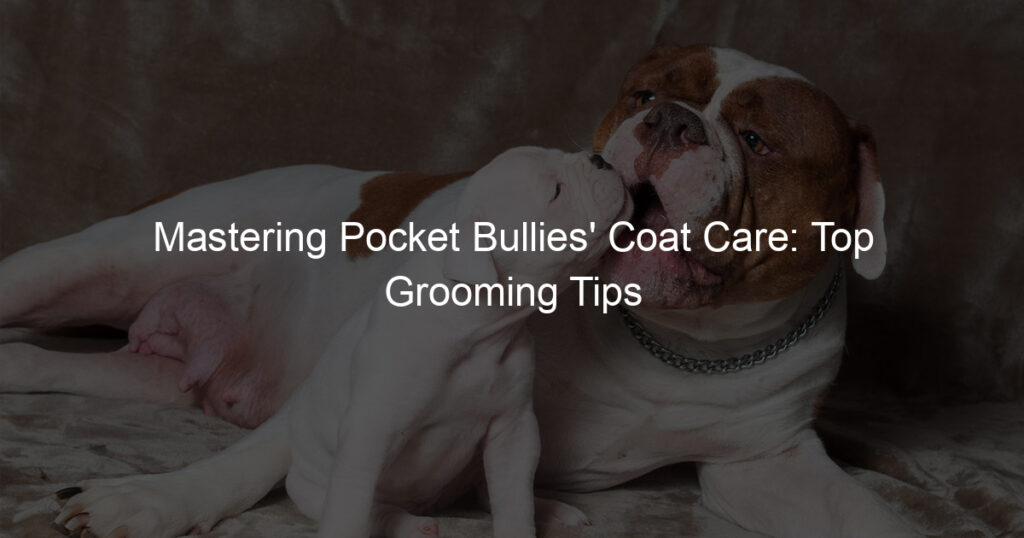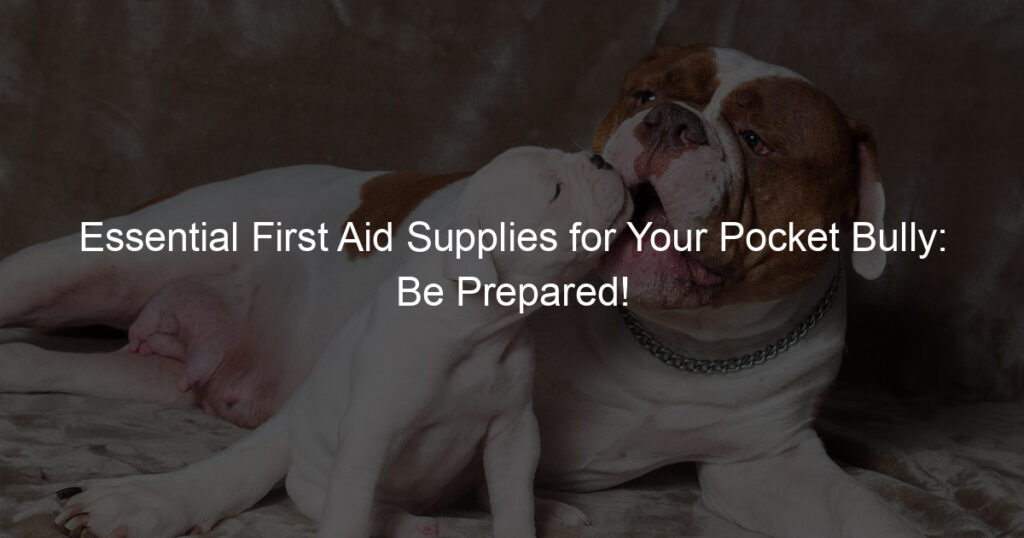
Introduction to Joint Health in Pocket Bullies
Just like humans, Pocket Bullies, a popular breed of dogs, also need to maintain good joint health. This is crucial for their overall well-being and longevity. In this section, we will delve into the importance of joint health in Pocket Bullies and discuss some common joint problems that they often face.
- Understanding the importance of joint health in Pocket Bullies
- Common joint problems in Pocket Bullies
Joint health is a key aspect of a Pocket Bully’s overall health. The joints play a pivotal role in providing mobility and flexibility to these dogs. Healthy joints allow them to run, jump, and play without any discomfort or pain. However, if their joints are not in good shape, it can lead to various health issues and affect their quality of life. Therefore, it is essential to understand the importance of joint health in Pocket Bullies and take necessary measures to ensure their well-being.
Pocket Bullies are prone to several joint problems due to their unique physique and genetic predisposition. Some of the most common joint issues they face include Hip Dysplasia, Elbow Dysplasia, and Patellar Luxation. Hip Dysplasia is a condition where the hip joint doesn’t fit together properly, causing pain and mobility issues. Elbow Dysplasia is a similar condition but affects the elbow joint. Patellar Luxation, on the other hand, is a condition where the knee cap slips out of place, causing discomfort and difficulty in movement. Early detection and treatment of these conditions can significantly improve the quality of life for these dogs.
Preventing Joint Issues in Pocket Bullies
Joint health is crucial for the overall well-being of your Pocket Bully. By taking proactive measures, you can prevent joint issues and ensure your pet enjoys a healthy, active life. Here are some steps you can take:
Proactive Measures for Pocket Bullies Joint Health
- Regular exercise and its benefits
- Importance of a balanced diet
- Role of regular vet check-ups
Regular exercise is essential for maintaining your Pocket Bully’s joint health. It helps to strengthen the muscles around the joints, reducing the risk of injury. Exercise also promotes flexibility and mobility, which can prevent joint stiffness. Aim for at least 30 minutes of moderate exercise daily, such as a brisk walk or a game of fetch.
A balanced diet is key to your Pocket Bully’s joint health. Ensure your pet’s diet is rich in nutrients like Omega-3 fatty acids, glucosamine, and chondroitin, which support joint health. Avoid feeding your pet foods high in sugar and processed carbohydrates, as they can lead to weight gain and put extra pressure on the joints.
Regular vet check-ups are crucial in preventing joint issues in Pocket Bullies. Your vet can monitor your pet’s weight, recommend a suitable diet and exercise plan, and detect any early signs of joint problems. Early detection can lead to more effective treatment and prevent further damage to the joints.
By following these proactive measures, you can help your Pocket Bully maintain healthy joints and enjoy a high quality of life. Remember, prevention is always better than cure when it comes to your pet’s health.
Joint Care Tips for Pocket Bullies
Ensuring the health and longevity of your Pocket Bully involves more than just regular exercise and a balanced diet. It also includes taking care of their joints. Here are some essential tips for joint care:
-
Proper grooming and care
Regular grooming is not just about keeping your Pocket Bully looking good. It’s also an opportunity to check for any signs of joint issues, such as swelling or tenderness. When grooming, pay special attention to your dog’s legs and paws. If you notice any changes, it’s crucial to consult with a vet immediately. Also, keep their nails trimmed to prevent them from putting unnecessary strain on their joints.
-
Importance of maintaining a healthy weight
Excess weight can put a lot of strain on your Pocket Bully’s joints, leading to problems like arthritis. Maintaining a healthy weight is critical for joint health. Feed your dog a balanced diet and ensure they get plenty of exercises. If you’re unsure about what constitutes a healthy weight for your Pocket Bully, consult with your vet.
-
Benefits of joint supplements
Joint supplements can be a great addition to your Pocket Bully’s diet. They can help maintain joint health and prevent issues down the line. Supplements like glucosamine and chondroitin can help maintain cartilage health, while omega-3 fatty acids can help reduce inflammation. Always consult with your vet before starting any new supplement regimen.
Remember, prevention is always better than cure. Regular vet check-ups, a healthy diet, and proper grooming can go a long way in ensuring your Pocket Bully’s joint health. So, take these tips to heart and help your furry friend live a long, happy, and healthy life.
How to Prevent Joint Issues in Pocket Bullies
Joint issues can be a common problem in Pocket Bullies, but there are ways to prevent these issues and keep your pet healthy. Here are some strategies that can help.
Prevention Strategies
- Early detection of joint problems
- Role of genetics in joint health
- Importance of regular physical therapy
One of the best ways to prevent joint issues in Pocket Bullies is through early detection. Regular check-ups with your vet can help identify any potential problems before they become serious. Signs of joint issues can include limping, difficulty moving, or a decrease in activity levels. If you notice any of these signs, it’s important to take your pet to the vet as soon as possible.
Genetics can play a big role in the health of your Pocket Bully’s joints. Some dogs are more prone to joint issues due to their genetic makeup. If possible, find out about the health history of your pet’s parents and siblings. This can give you a better idea of what to expect and how to prepare.
Regular physical therapy can be a great way to prevent joint issues in Pocket Bullies. This can include exercises to strengthen the muscles around the joints, as well as massage and other therapies to improve joint health. Your vet can provide you with a list of recommended exercises and therapies for your pet.
By following these strategies, you can help prevent joint issues in your Pocket Bully and ensure they live a long, healthy life. Remember, the key to prevention is early detection and regular care.
Case Studies: Pocket Bullies Joint Health Measures
Let’s delve into some real-life examples to better understand how joint health issues can be prevented and managed in Pocket Bullies. These case studies provide practical insights into the effectiveness of various measures taken by pet owners.
- Case study 1: Successful prevention of joint issues
- Case study 2: Managing existing joint problems
Meet Max, a lively Pocket Bully who just turned 5. Max’s owner, Sarah, has been proactive about his joint health since he was a puppy. She ensured Max maintained a healthy weight, which is crucial as obesity can put unnecessary strain on a dog’s joints. Sarah also provided Max with a balanced diet rich in Omega-3 fatty acids, known to support joint health.
Max was also regularly exercised, but Sarah was careful to avoid high-impact activities that could harm his joints. Regular vet check-ups were a part of Max’s routine, ensuring early detection of any potential issues. Today, Max is a healthy adult Pocket Bully with no joint issues, thanks to Sarah’s preventive measures.
Then there’s Bella, a 7-year-old Pocket Bully who started showing signs of joint discomfort at age 4. Bella’s owner, John, noticed her difficulty in climbing stairs and her decreased activity levels. After a vet confirmed Bella had early-stage arthritis, John took immediate action.
John adjusted Bella’s diet to include supplements like glucosamine and chondroitin, known to support joint health. He also introduced low-impact exercises into Bella’s routine, like swimming, to help maintain her muscle strength without straining her joints. Bella’s vet also prescribed a pain management plan, including medication and regular check-ups to monitor her condition.
Today, Bella’s joint issues are well-managed. She’s more active and shows less discomfort, demonstrating that even with existing joint problems, Pocket Bullies can lead a comfortable life with the right care.
These case studies highlight the importance of both preventive measures and effective management strategies in maintaining the joint health of Pocket Bullies. Remember, every dog is unique, and what worked for Max or Bella may not necessarily work for your Pocket Bully. Always consult with a vet for personalized advice.
Conclusion: Ensuring Joint Health in Pocket Bullies
As we reach the end of our discussion on joint health in Pocket Bullies, it’s crucial to remember that these adorable dogs deserve a life free from joint pain. By being proactive and informed, we can help them lead a healthy, active life. Let’s summarize the key takeaways and emphasize the importance of proactive joint care.
- Key takeaways for preventing joint problems in Pocket Bullies
- Importance of proactive joint care
Firstly, a balanced diet rich in essential nutrients is fundamental to your Pocket Bully’s joint health. Foods rich in Omega-3 fatty acids, glucosamine, and chondroitin can help maintain healthy joints. Regular exercise, not too strenuous, can also keep their joints flexible and strong.
Secondly, regular vet check-ups are essential to detect any early signs of joint issues. Remember, early detection can make a significant difference in managing and treating joint problems. Also, keep an eye on your dog’s weight. Excess weight can put unnecessary pressure on their joints, leading to problems.
Proactive joint care is not just about treating joint issues when they occur; it’s about preventing them from happening in the first place. By providing your Pocket Bully with a healthy lifestyle, you are not only ensuring their happiness but also preventing potential health issues.
Proactive care includes regular exercise, a balanced diet, and regular vet check-ups. It also involves monitoring your dog’s weight and ensuring they are not putting unnecessary strain on their joints. Remember, a healthy Pocket Bully is a happy Pocket Bully.
In conclusion, joint health in Pocket Bullies is a topic of utmost importance that requires our attention and care. By following these guidelines, we can ensure that our beloved pets lead a healthy, active, and pain-free life. Let’s commit to being proactive in caring for our Pocket Bullies’ joint health.














